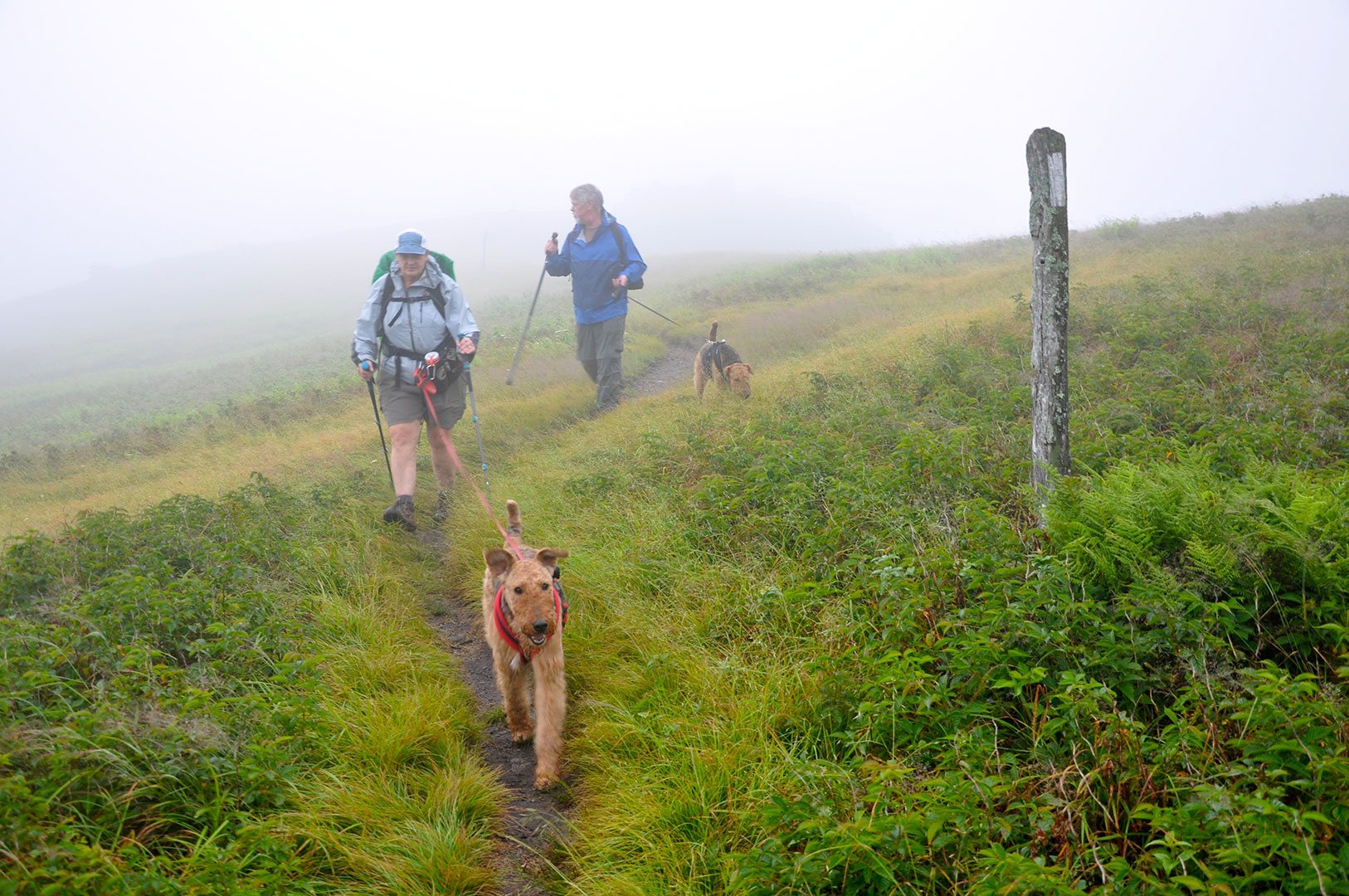By Luann Mack-Drinkard
Hiking with Dogs
Tips for taking four-legged friends on your next Appalachian Trail adventure.
My husband and I were on a short overnight hike with our two terriers, from the Trail just north of Damascus, headed for our campsite at Saunders Shelter. As we approached the Trail junction to Taylors Valley, our older dog, Tali, alerted to something ahead. Hackles raised, she slowly backed away growling and barking, and refused to go forward. It was a sunny day and we could see the way ahead just as well as Tali, but neither my husband nor I saw any sign of danger. We tried to coax her forward, but she would have none of it and continued barking and balking. At this point I could feel my own adrenaline rising as I was certain my dog had spotted a danger that I could not see. Eventually, we realized she was alerting to a burned and blackened tree stump beside the Trail, which she may have thought was a bear. My husband ultimately had to carry her past the “bear” so we could continue our hike.
For a dog lover, one of the best things about the Appalachian Trail is being able to take your dog with you when you go hiking. Our dogs clearly love being outdoors and they love being with us. Over the past four decades we’ve shared many memorable Trail moments with our dogs and our lives have been enriched through those shared hiking experiences.

Doggy Etiquette
The Basics
What’s the most important thing you should do to make sure you have a good hiking experience with your dog? Training. Dogs need to know or learn basic manners: sit, down, stay, not jumping up on fellow hikers, not stealing food. Taking a dog training class is a good place to start preparing for hikes with your dog.
On the Trail, you are responsible for your dog. This includes maintaining control. The Appalachian Trail Conservancy pet policy recommends that dogs be leashed at all times. Keeping your dog on leash is a small price to pay for being able to share hiking adventures with them.
Your responsibility for your dog includes making sure he or she remains healthy and comfortable when hiking. Flea and tick control are a must, and there are many options to choose from. Vaccinations, including rabies, distemper, parvovirus, and adenovirus-2 are also essential. (It’s also a good idea to carry proof of your dog’s current vaccinations with you when you travel.) Remember to offer your dog water anytime you stop for a drink. If you are thirsty, your dog will be, too. Just like us, dogs are burning more calories when hiking, so they need more food. We bring lunch for our dogs even on day hikes, especially if they are carrying a pack. Town or Trail, remember food and water for your companion.
Good Behavior on the Trail
In my opinion, it is better to use a harness than a collar when hiking with your dog. A harness is easier on a dog’s body. A sturdy six-foot leash is a good choice. If you chose to use a retractable leash, use the belt version instead of the cord. Know that some areas require a dog’s leash to be no longer than six feet (Shenandoah National Park is one of these) so you’ll have to lock your retractable leash at six feet while hiking in these areas.
 A sturdy leash and harness will help ensure that your dog is safe and comfortable during your hike.
A sturdy leash and harness will help ensure that your dog is safe and comfortable during your hike.
Remember, not everyone you meet on the Trail will love your dog as much as you do. One thing we’ve learned to do is to move our dogs to the side of the Trail when another hiker approaches. We tell our dogs to sit and wait as the hiker passes. Some hikers thank us, and most stop to chat and to greet our dogs.
Finally, we must talk about poop. Because your dog is not a natural inhabitant of the area, carry poop bags, pick up the poop, and carry it out. If you’re backpacking, take your trowel and bury your dog’s waste just as you would your own. Hikers who follow will thank you.
When and Where to Hike
Most Trail sections are suitable for hiking with your dog, but some restrictions and common-sense exceptions do exist. Three A.T. areas are off-limits: The Great Smoky Mountains National Park, Bear Mountain State Park Trailside Museum and Zoo, and Baxter State Park. The White Mountains of New Hampshire and parts of Maine are rocky and steep, and could be uncomfortable for your dog. And the notorious rocks of Pennsylvania could be just as painful for your dog as they are for you. Think about the physical shape your dog is in before asking your pet to do too much. Check the weather before deciding to take your dog for a hike. Summer heat may be too much for a heavily coated breed, while winter’s cold could be harmful for a smooth coated breed.
Overnight Stays
Finding pet-friendly lodging along the Trail is not nearly as difficult as it used to be. Many hotels and motels advertise as pet-friendly, often charging a small fee for allowing you to keep you dog in your room. And being prepared to tent camp instead of stay in a shelter is good etiquette while overnighting on the Trail with your dog.
This article was originally published in the Spring 2019 issue of A.T. Journeys Magazine. Become an ATC member today and receive a year’s subscription!

Luann Mack-Drinkard is an A.T. 2000-miler and a licensed veterinary technician specializing in physical rehabilitation. She, her husband Dee (also a 2000-miler) and their two Airedale Terriers, Airen and Peri, travel as often as they can to partake of the soul-reviving joys and beauty that abound on the Appalachian Trail. They all abide in Danville, Virginia.
Discover More

Plan and Prepare
Hiker Resource Library
A collection of resources for hikers to stay safe, healthy, and responsible on the Appalachian Trail.

BACK TO THE BASICS
Leave No Trace
Wondering how you can take care of outdoor places like the Appalachian Trail (A.T.)?

ATC's Official Blog
A.T. Footpath
Learn more about ATC's work and the community of dreamers and doers protecting and celebrating the Appalachian Trail.
